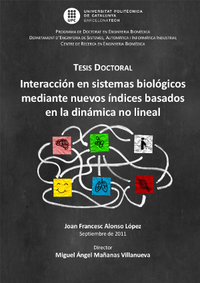J. F. Alonso, 2011
Interaction in biological systems using new indices based on nonlinear dynamics
By Joan Francesc Alonso
Directed by Miguel Ángel Mañanas
2011.09.29Summary

Most biological systems are complex and consist of several interconnected parts whose links can contain additional information which can be hidden from the observer. As a result of the interactions between elements, emergent properties that cannot be explained by the characteristics of isolated elements can arise.
Current clinical applications record a high number of different signals that contain information about these physiological systems, providing multichannel data whose interactions can be studied by classical reference methods, generally linear, as the correlation analysis and spectral coherence, and other nonlinear methods that are being defined and developed during recent years, such as nonlinear prediction, entropies, mutual information and phase synchronization.
The development, improvement and application of new analytical techniques is a field with obvious social and technological interest, especially when performed by noninvasive techniques, which can improve the processes of rehabilitation and clinical therapy, and also help the development of new diagnostic tools.
- The coordination of respiratory muscles in healthy subjects and patients with obstructive sleep apnea syndrome (OSAS) during an effort ventilatory protocol.
- The effect on functional connectivity of the brain after administration of a psychoactive drug.
- The changes caused by Alzheimer's disease (AD) in the connectivity of the brain.
Respiratory muscles provide the mechanical energy that supports respiration. The evaluation of interactions between electromyographic (EMG) and mechanomiographic (MMG) signals of different respiratory muscles, genioglossus, sternomastoid and diaphragm, has allowed the discrimination of coordination patterns of OSAS patients with respect to healthy subjects at low, medium and high respiratory effort during while awake.
Analysis and characterization of the electroencephalographic (EEG) and magnetoencephalographic (MEG) signals allows the understanding of brain function to assist in the process of clinical diagnosis of disorders in neurology, psychiatry and pharmacology. In this thesis the interactions within and between different brain regions have been assessed, using new nonlinear indexes which have managed to reflect changes over time in the brain after administration of alprazolam, and to characterize andto differentiate brain connectivity of AD patients with respect to healthy subjects.
The tools used in the listed applications are based on the following nonlinear analysis techniques:
- The cross-mutual information function, the nonlinear counterpart of cross-correlation function, which quantifies the shared information between two random variables.
- The corrected cross conditional entropy, a measure that quantifies the remaining information contained in a random variable when another related variable is fully known, and thus it is a complementary measure of mutual information.
- The nonlinear prediction based on locally linear models, a mathematical tool that allows to deduce the evolution of a series using previous samples.
These developed indexes have demonstrated the need to evaluate the interactions in biological and physiological systems by means of both linear and nonlinear methods, to obtain a more complete assessment of the underlying dynamic processes and to assist the diagnostic process of pathologies and during psychopharmacological evaluation.
Share: